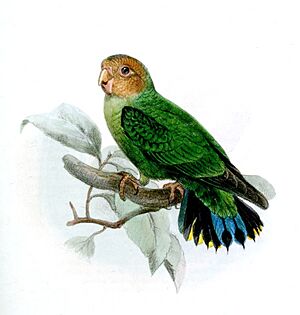Buff-faced pygmy parrot facts for kids
Quick facts for kids Buff-faced pygmy parrot |
|
|---|---|
 |
|
| Conservation status | |
| Scientific classification | |
| Genus: |
Micropsitta
|
| Species: |
pusio
|
The buff-faced pygmy parrot (Micropsitta pusio) is a super tiny green parrot. You can find it living in warm, wet forests near the equator in places like New Britain and New Guinea. It's known for being one of the smallest parrots in the world!
Contents
About the Buff-faced Pygmy Parrot
This little parrot is mainly green. It has a yellowish color on its belly. Its cheeks, face, and the top of its head are a light, creamy brown color, which is why it's called "buff-faced." There's also a dark blue spot on the very top of its head.
Male and female buff-faced pygmy parrots look quite similar. However, females usually have smaller head markings and a paler face color. Their eyes are dark brown, and their beaks are grey. Their legs are also greyish, sometimes with blue or pink hints. Young parrots don't have the blue spot on their heads; it's green instead, and their buff face color isn't as clear.
How Small Is It?
The buff-faced pygmy parrot is famous for being the world's smallest parrot! It's only about 8.6 cm (3.4 in) long. That's shorter than a standard pencil! It weighs around 11.5 g (0.41 oz), which is lighter than a few coins. Even though it's tiny, it's a very active bird, always hopping around on tree trunks.
Where It Lives and What It Eats
Buff-faced pygmy parrots live in the lowlands of the island of New Guinea. You can also find them in the Bismarck Archipelago. They prefer warm, moist forests up to about 800 meters (about 2,600 feet) above sea level.
These parrots usually live in small groups of up to six birds. They are very busy and active, often seen climbing and moving quickly on tree trunks. Unlike many parrots that eat seeds and fruits, pygmy parrots are special because they mostly eat lichen and fungus that grow on tree bark. They use their strong beaks to pick these tiny bits off the trees.
Naming and History
The buff-faced pygmy parrot was first officially described in 1866 by an English scientist named Philip Lutley Sclater. He gave it the scientific name Nasiterna pusio at first.
Later, its genus name became Micropsitta. This name comes from two Greek words: mikros, which means "small," and psittakos, which means "parrot." So, Micropsitta literally means "small parrot." The second part of its scientific name, pusio, is a Latin word that means "little boy." This perfectly describes this tiny bird!
Conservation Status
Even though we don't know exactly how many buff-faced pygmy parrots there are, they live across a very wide area. Because of this, the IUCN lists them as a species of "least concern." This means they are not currently considered to be in danger of disappearing.


